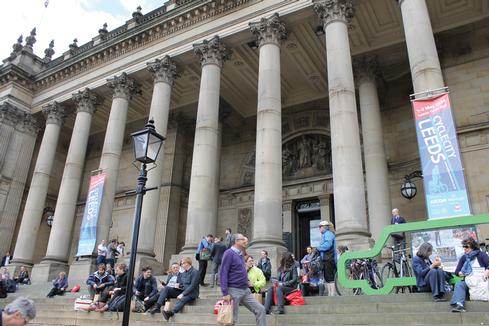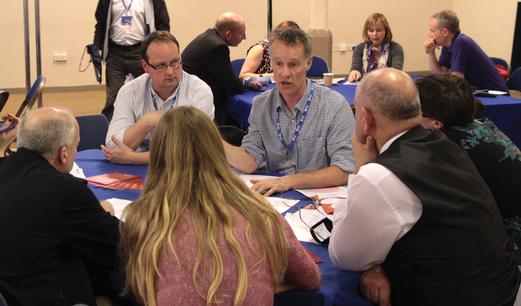


More than 500 delegates attended Cycle City expo in Leeds on 1-2 May, confirming its position as the UK’s largest cycling planning and policy event. The gathering, organised by Landor LINKS and hosted by the West Yorkshire Combined Authority, brought together experts from local and central government, the private sector, third sector as well as campaign groups and consultancies.
Cycling practitioners discussed a range of topics including segregated routes, marketing, behaviour change, travel plans, commuter cycling, bike hire, shared space design, safer HGVs, electric bikes and cycle logistics.
There was a large exhibition representing all facets of the cycling sector, as well as an outdoor area that attracted more than 1,000 visitors.
Cycle City was opened by roads minister Robert Goodwill, who announced measures to help councils make roads safer for cyclists. These include proposals for low-level signals for cyclists, new types of crossings for pedestrians and cyclists and a new advanced stop line design.
“We will also trial new dedicated cycle streets,” said Goodwill. “This will give councils the opportunity to put cyclists on an equal footing with motorists on popular cycle routes by banning overtaking.”
He told delegates: “We shouldn’t start from the point of view that it is either room for cycling or space for other road users. In fact, the opposite can be true. If you put in place high quality, integrated cycling infrastructure that makes people feel safe, it increases the number of people who travel by bike and that means fewer people feel the need to take their car.
“Cycling is a relatively cheap, healthy and safe way to travel short distances – it means quicker journeys for everyone. UK road congestion is already among the worst in Europe, particularly in urban areas. If we do not make more efficient use of the available space in our towns then traffic will simply come to a standstill.”
Goodwill urged the cycling lobby to keep a sense of proportion when discussing safety. “I know we need to make cycling safer, and it is right that people campaign for greater safety. But we should take care not to send out the message that cycling is dangerous, when it isn’t,” he said.
He challenged the perception that cycling in London is dangerous, pointing out that while cycling numbers in the capital have increased over the past ten years the number of fatalities involving cyclists has dropped from 21 to 14. “When you are campaigning for more funding, try not to go on about safety,” he advised.
During the opening plenary, Leeds Cycle Campaign chair Lizzie Reather highlighted that many people cycled for reasons other than commuting. “In many cases people cycle for local journeys, say a half mile or one mile journey to the local shops. For that you need a local network to be in place.”
The UK is lagging behind in its development of good quality cycle networks, said Reather. “This has its drawbacks but also its advantages, as we can learn from what has been done in places like Seville, Nantes, Berlin and New York without having to copy them.”
Bedford Borough Council spoke about its plans to install a ‘two-lane compact roundabout’ influenced by Dutch thinking in Bedford.
The two-lane design will feature spiral lanes, which will “result in fewer conflicts points and reduce vehicle speeds to under 15mph”, said Patrick Lingwood, Bedford Borough Council’s walking and cycling officer. “The designs have been tried and tested in the Netherlands. We are adapting it with the aim of making the roundabout safer. We have carried out a lot of research and we expect it to work, but we can’t be 100% sure. If it does work, then it will offer a template to other local authorities.”
Last April the council was awarded £420,000 from the DfT’s Cycle Safety Fund, and the scheme was due to be installed last summer. But Lingwood explained that the scheme has faced delays due to safety concerns expressed by the motorcycling lobby. The Motorcycle Action Group believes the plastic lane dividers designed to encourage traffic to follow the correct lane and make vehicles slow down pose a threat to bikers who either may not see them or may strike them when trying to avoid a collision.
Lingwood said he was meeting with the motorcycle lobby to discuss adjustments to the scheme, which should be implemented this summer.
One of the recurring themes at Cycle City was the competition for space between cyclists and other road users. Andy Thorpe from Sandwell Metropolitan Borough Council explained how he gets local cycling groups to carry out “spot analyses” on proposed routes.
But the needs of cycling groups did not always sit well with the visually impaired, said Thorpe. “We have had meetings with disability groups. We have collected quite a bit of data to see how much conflict there might be, and have to assess whether or not shared spaces work.”
Sandwell encourages road users to “share with care”, and most issues between cyclists and pedestrians tend to be fully resolved, said Thorpe. “But long consultation periods can result in us having unspent budgets at the end of the year.”
The race to spend budgets within deadline was discussed at a ‘speed networking’ session on the DfT’s Cycle City Ambition grant projects. The Department expects the projects to be largely completed by March 2015, with reports on the delivery of outputs by September 2015 and evaluation results by March 2016. Representatives from all the winning projects, which have been awarded a total of £94m, outlined their plans at Cycle City.
Birmingham City Council, which has been awarded £17m, is planning improvements to routes that are a 20-minute bike ride from the city centre. Richard Leonard, the council’s team leader transportation strategy, said: “We have a year to spend the Ambition Grant money, which will be a real challenge. We won’t be putting in heavy segregation as we haven’t got time for that. We plan to create some new cycle lanes and put in light segregation using ‘Armadillos’ – the aim is to create space for cyclists to encourage usage.”
The council will also be offering cycle hire through a scheme known as Big Birmingham Bikes, with 5,000 cycles and 15 hubs planned, said Leonard.
Work is underway to make canal towpaths, former railway lines and ‘green’ routes more cycle friendly by installing all-weather tracks and removing under-utilised parking spaces to provide more space for bike routes.
In Hertfordshire, existing cycle routes along canal towpaths and former rail lines are being further improved. The creation of on- and off-road links from these core routes to stations, retail areas and business parks is also underway, including the St Albans Green Ring and the Hemel Hempstead to Maylands Link.
Winning hearts and minds to cycling was one theme of a presentation by Stephen Lloyd Jones, who runs Hertfordshire’s Local Sustainable Transport Fund-funded business engagement programme BigHertsBigIdeas for Business, which promotes sustainable staff travel to large employers in south-west Hertfordshire.
He spoke of the need to create and maintain a calendar of communication and events such as the BigHerts Cycle Challenge. “This can then feed into companies’ own internal communications methods and start to change behaviour,” said Lloyd Jones. “Selected funding of facilities also helps large organisations reduce congestion and parking issues around their sites and helps retain and create jobs.”
Lloyd Jones cited the case of Watford General Hospital’s staff cycle hub, which offers shower facilities as well as cycle parking provision for staff. He also discussed how partnerships with rail operators were boosting commuter cycle parking at stations, with St Albans leading the way with more than 1,000 parking places on offer.
Cycle-rail is the largest single generator of new cycle journeys in the UK, according to Conrad Haigh, head of integrated transport at ATOC. Rail trips involving the use of a bike have increased from 25.2 million in 2009/10 to 39.1 million in 2012/13, said Haigh. “The number of cycle parking spaces at stations has gone up from 23,441 in 2009/10 to 53,333 in 2012/13 and is projected to increase further to 68,996 in 2014/15.”
There are around 1,400 hire cycles and about 30 cycle hubs now available at stations, he said.
Infrastructure developer Streetsure reported that it is building a two-tier cycle park at Cambridge rail station, which is due to be completed in June. The double decker racks, which will provide parking for more than 1,000 bikes, will act as stopgap until a 3,000 bike park is installed next year, said Streetsure’s general manager Jason Devenish. He said there is currently space for 800 bikes at Cambridge rail station, but the facility is substandard. “Cycle parking is currently a mess,” he said. “There are lots of abandoned bikes. The orderly nature of two-tier racks will solve this problem.”
A host of new innovations were showcased at Cycle City, among them mapping, wayfinding and smartphone apps. Henrietta Sherwin from the Centre for Transport and Society at the University of the West of England (UWE) called for a new generation of maps that are shaped by users and based on local knowledge.
“The catalyst for my interest in cycle mapping was the experience of trying to use the local cycle maps to find my way on a bicycle in several cycling demonstration towns and cities as part of a DfT evaluation,” she said. “I was struck by the variety of styles and found some were not fit for purpose. It became clear that a lot of local authorities were spending money on maps but had little knowledge of how they are being used.”
She said rapid advancements in technology meant that the data underlying cycle maps would increasingly be “crowd sourced”.
“There will still be issues of accuracy and clarity but the information will be constantly changing and kept up to date. The issue of trust is critical and, in interviews conducted for the DfT, it became clear that many ‘new’ cyclists, those who had started cycling in the last 18 months, were relying on ‘word of mouth’ information from trusted individuals in their social networks to find suitable routes.”
New technology can harness this social influence by allowing individuals to convey their experience of cycling a particular route on a map and sharing this information with others, said Sherwin.
Caroline Bartle, Sherwin’s colleague at UWE, said the next step was to incorporate this data into a closed interactive map within institutions to enable individuals to exchange information and measure the extent to which this social influence can encourage cycling.
“We need to learn how to incorporate the social element into cycle mapping to add weight and trust,” said Bartle. “We are currently looking for collaborators to develop and test such a system.”
TransportXtra is part of Landor LINKS
© 2025 TransportXtra | Landor LINKS Ltd | All Rights Reserved
Subscriptions, Magazines & Online Access Enquires
[Frequently Asked Questions]
Email: subs.ltt@landor.co.uk | Tel: +44 (0) 20 7091 7959
Shop & Accounts Enquires
Email: accounts@landor.co.uk | Tel: +44 (0) 20 7091 7855
Advertising Sales & Recruitment Enquires
Email: daniel@landor.co.uk | Tel: +44 (0) 20 7091 7861
Events & Conference Enquires
Email: conferences@landor.co.uk | Tel: +44 (0) 20 7091 7865
Press Releases & Editorial Enquires
Email: info@transportxtra.com | Tel: +44 (0) 20 7091 7875
Privacy Policy | Terms and Conditions | Advertise
Web design london by Brainiac Media 2020